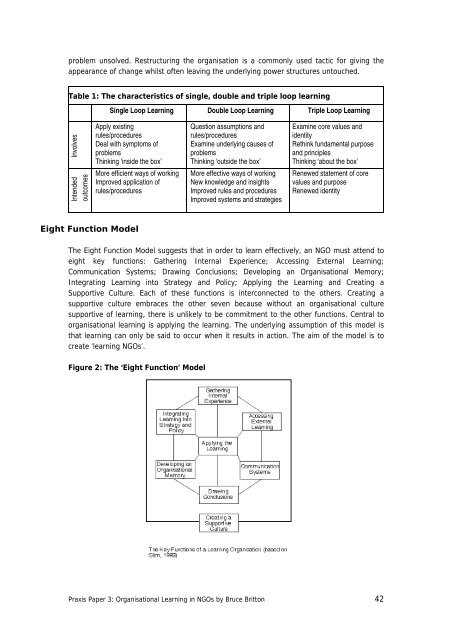Organisational Learning Discussion Paper - Are you looking for one ...
Organisational Learning Discussion Paper - Are you looking for one ...
Organisational Learning Discussion Paper - Are you looking for one ...
You also want an ePaper? Increase the reach of your titles
YUMPU automatically turns print PDFs into web optimized ePapers that Google loves.
problem unsolved. Restructuring the organisation is a commonly used tactic <strong>for</strong> giving the<br />
appearance of change whilst often leaving the underlying power structures untouched.<br />
Table 1: The characteristics of single, double and triple loop learning<br />
Involves<br />
Intended<br />
outcomes<br />
Single Loop <strong>Learning</strong> Double Loop <strong>Learning</strong> Triple Loop <strong>Learning</strong><br />
Apply existing<br />
rules/procedures<br />
Deal with symptoms of<br />
problems<br />
Thinking ‘inside the box’<br />
More efficient ways of working<br />
Improved application of<br />
rules/procedures<br />
Eight Function Model<br />
Question assumptions and<br />
rules/procedures<br />
Examine underlying causes of<br />
problems<br />
Thinking ‘outside the box’<br />
More effective ways of working<br />
New knowledge and insights<br />
Improved rules and procedures<br />
Improved systems and strategies<br />
Examine core values and<br />
identity<br />
Rethink fundamental purpose<br />
and principles<br />
Thinking ‘about the box’<br />
Renewed statement of core<br />
values and purpose<br />
Renewed identity<br />
The Eight Function Model suggests that in order to learn effectively, an NGO must attend to<br />
eight key functions: Gathering Internal Experience; Accessing External <strong>Learning</strong>;<br />
Communication Systems; Drawing Conclusions; Developing an <strong>Organisational</strong> Memory;<br />
Integrating <strong>Learning</strong> into Strategy and Policy; Applying the <strong>Learning</strong> and Creating a<br />
Supportive Culture. Each of these functions is interconnected to the others. Creating a<br />
supportive culture embraces the other seven because without an organisational culture<br />
supportive of learning, there is unlikely to be commitment to the other functions. Central to<br />
organisational learning is applying the learning. The underlying assumption of this model is<br />
that learning can only be said to occur when it results in action. The aim of the model is to<br />
create ‘learning NGOs’.<br />
Figure 2: The ‘Eight Function’ Model<br />
Praxis <strong>Paper</strong> 3: <strong>Organisational</strong> <strong>Learning</strong> in NGOs by Bruce Britton<br />
42
















![CynefinFramework final [Read-Only]](https://img.yumpu.com/19017304/1/190x135/cynefinframework-final-read-only.jpg?quality=85)